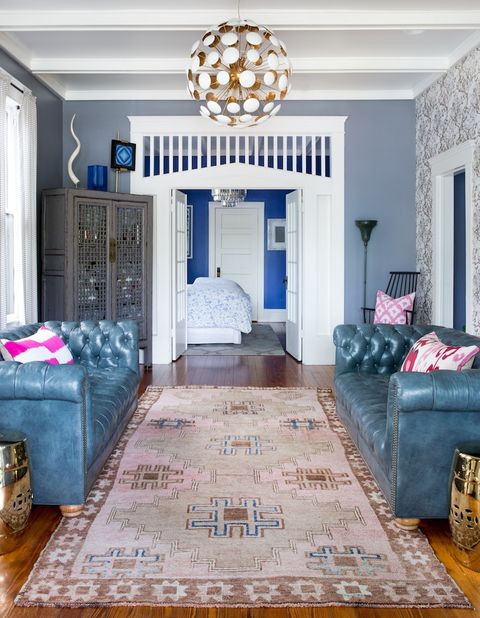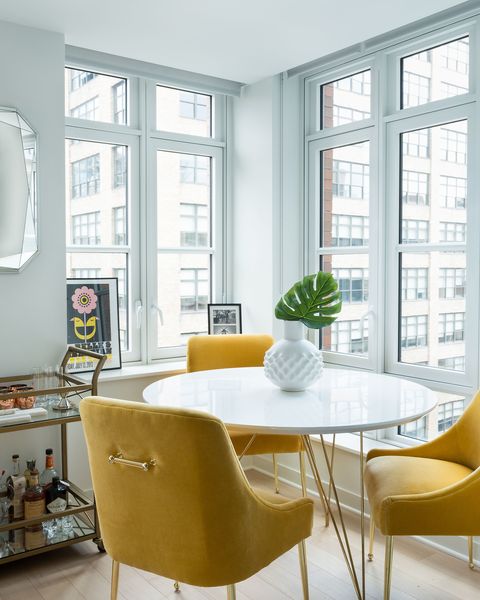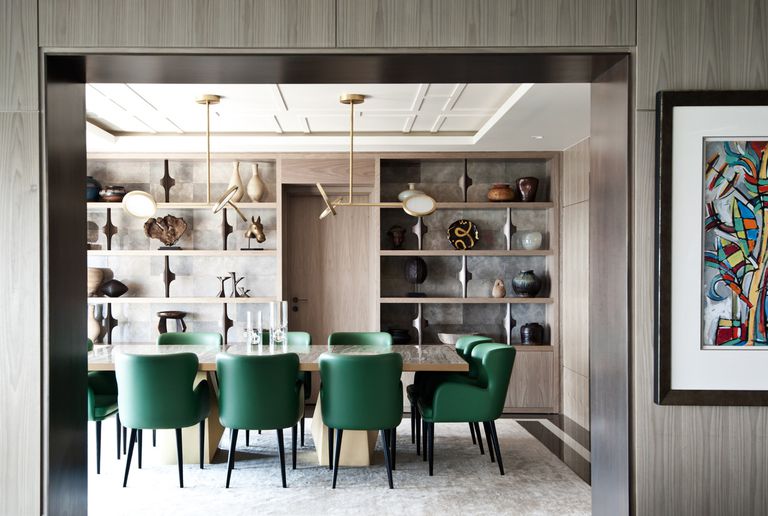Your color palette makes a huge difference.
Bronze, brass, nickel, or chrome? Choosing metals for your home can be daunting, so here's a suggestion: Don't choose just one. All the best designers know there's no magic in being matchy-matchy—and that policy is true for metals as well as bedroom sets. Instead of agonizing over the "right" metallic finish, consider mixing them up.
We realize this concept might be daunting to some, so, to help you out, we asked several designers about their favorite ways to mix metals—and boy, did they deliver: From chic and minimalist to all out eclectic, here are their top ways to utilize this trend. Take notes, and your home might never be the same.
1. Create a strong base.
Often times, metallics look out of place in a home because they're not set against the right base. Think of it like renovating a home—you need your foundation right before you start layering in all your beautiful furniture, right? So if your base is, say, bright red, copper would just clash and leave you feeling like your home has no unity.
“In terms of metals, the use of darker hues, such as antique or blackened brass/bronze, can act as a neutral base that is easy to mix with brighter hues,” explain Brian DeMuro and Puru Das of New Delhi -based design firm DeMuro Das. In this way, you can play with several colors and finishes that’ll stand out from the baseline, but still capture attention. “The colors will blend together beautifully, but at the same time, provide visual interest throughout the room,” elaborate the designers.
Or, you could go the opposite route and pick your base as a lighter color, and then layer on darker finishes on top. Either way, that contrast is what will create harmony. You know the old saying about opposites...

A living room by Kim West.COURTESY OF KIM WEST
2. Pick a theme.
Realize that even if you decide to incorporate mixed metals into your home, that doesn’t necessarily mean you’re losing your sense of personal style. For instance, if you love your modern farmhouse aesthetic, adding in metals doesn’t have to change that. What you do need to be aware of, though, is that the metals you pick need to co-exist with the items you already own—so, say, brass and crafted woods for farmhouse, or silver and white for a modern vibe.
“Pulling together inspiration is always a great place to start,” says Kim West, interior designer and co-founder of Supply Showroom. “Think about spaces you hope to emulate, and think about how metal is used in those spaces.” And don’t think mixing metals means you can’t play around a bit in a minimalist space, either—”If the area is simple, I love the idea of powder-coated metals in whites and blacks sitting alongside a vintage mixed metal piece, just to add a little dimension,” elaborates West.
3. Make sure it’s not completely random.
Mixing metals can be a fun experiment, but it does require some planning and structure, insist DeMuro Das. “The mixing needs to look deliberate, not random,” the designers explain. They recommend picking one main metal color to focus on, and then using an opposing color as an accent or focal point in the room (for inspiration, see this Knoxville bathroom, where bright brass takes center stage while dark bronze supports).
“Another option is to spread the different metals around, achieving a kind of harmony between them all," the designers explain. But make sure you even out the spread: "You can go wrong mixing metals when the balance is off—maybe there's too much of one color clumped together, or the eye is confused in terms of where the focal point is,” they explain.

A corner dining space by Larisa Barton.COURTESY OF THE DESIGNER HOMEPOLISH
4. Try it with accessories.
If you’re too scared to go all out with finishes, it’s always a good idea to start small—but don’t go the basic route by just picking two colors on one hanging light fixture and calling it a day. Instead, try using accessories to give your home the punch it needs, without too much commitment.
“By introducing only one piece of chrome in a sea of brass, for instance, it looks like a mistake,” elaborates Homepolish designer Larisa Barton. “If you pepper in a couple of items in each metal, there is a purpose to it and a better flow.” This is why it makes more sense to use a multitude of smaller accessories in different metallic finishes, such as using your open shelving to display a combination of metal glasses in the kitchen, or experimenting with a few chrome and nickel centerpieces for your dining table. It’ll give you a taste for the trend, while also sparking the courage to try something more daring the next time.
5. Don’t stick to the same color family.
Just because you’re mixing metals, that doesn’t mean they have to be entirely different from each other: There’s beauty in cohesion, too, so you can absolutely mix a combination of either cool tones or warm—you don’t have to make sure you have both in one room.
But watch out for having them all the same exact color, with only the finishes being different: According to Homepolish designer Amanda Sacy, it just makes it seem like you couldn’t match your finish. “You want to achieve that perfect balance with your metals,” she explains. “Stick to two or three different metals—you don't want to overload your space with metallics.”
Source: housebeautiful.com













